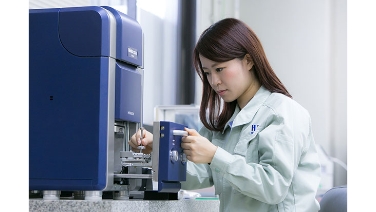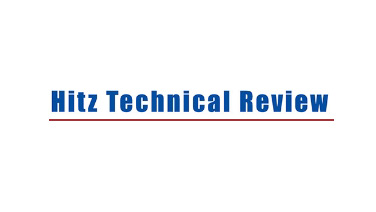Electro-chlorination Systems
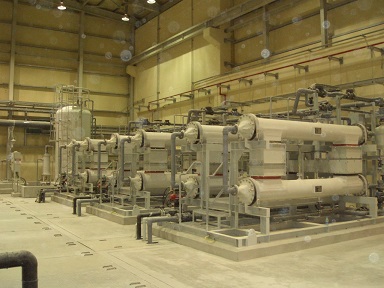
Daiki Hychlorator®: Land electro-chlorination equipment for factories
Daiki Hychlorator® / Daiki Capionator®: Marine fouling prevention device
An electrolyzer (electro-chlorination equipment) prevents the adhesion of marine organisms such as microorganisms and shellfish by directly electrolyzing seawater or salt water to produce sodium hypochlorite.
Electrolyzers are installed and used in power plants, various other plants in coastal industrial areas, and ships.
They are also used for improving water quality, maintaining transparency, and sterilizing waterworks at facilities such as aquariums.
Features
- An electrolyzer is an anti-fouling device with high safety and reliability. Hitachi Zosen has an extensive record of delivering electrolyzers.
- The only raw materials used are seawater (salt water) and electricity, and the running cost is low compared to chemical injection.
- Stable operation is achieved because there is no need to consider changes in concentration due to aging.
- A special precious metal coated electrode developed by Hitachi Zosen is used for the electrode, which is the heart of the product. This realizes low cost, high efficiency, and long life.
- Remote diagnosis using smart glasses is also possible.
Major products
Principle
By passing a direct current through seawater or salt water, the electrolyzer generates chlorine (Cl2) on the anode surface and caustic soda (NaOH) on the cathode surface.
The chlorine and caustic soda react to produce sodium hypochlorite (NaClO).
Additionally, hydrogen, which is a by-product generated on the cathode surface, is separated by a device such as a deaeration cylinder and then safely released into the atmosphere.
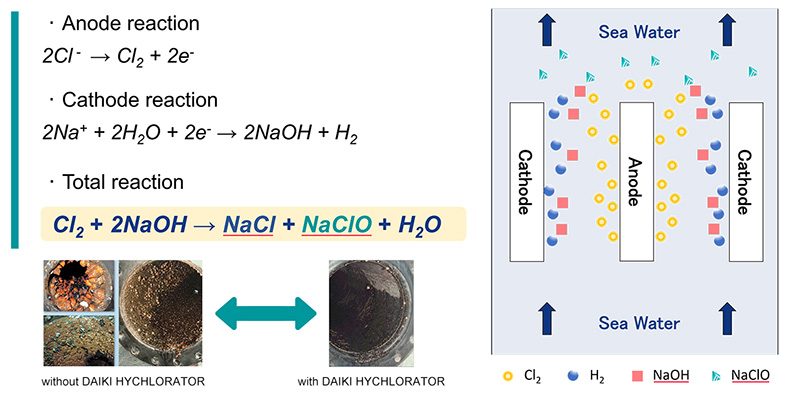
Daiki Hychlorator®: Land electro-chlorination equipment for factories
The Daiki Hychlorator is a highly safe and reliable anti-fouling device with a record of use at nuclear plants.
Sodium hypochlorite produced by electrolyzing seawater is injected into the seawater intake, etc., in order to prevent blockage in the pipe due to the adhesion of marine organisms.
Hitachi Zosen started selling seawater electrolyzers in 1967. We are now a top manufacturer with an outstanding track record in Japan and overseas. We mainly handle equipment for power plants and seawater desalination equipment.
We have made more than 300 deliveries (as of February 2021) in Japan and overseas. Our products have been adopted in many nuclear power plants in Japan where safety and reliability are of the utmost important.
System components
Hitachi Zosen offers three types of seawater electrolyzers: a direct delivery system, a receiver tank system, and a circulation system.
Electrolytic tank lineup
There are two types of our electrolytic tanks: unipolar and bipolar. Hitachi Zosen uses high-performance, long-life anodes which we develop and manufacture in-house.
Unipolar electrolytic tank
We have delivered 150 unipolar electrolytic tanks in Japan and 50 overseas. Our electrolytic cells feature a structure (patented) that minimizes clogging due to scales, so cleaning off scales once a year is sufficient.
| Type | 6L | 10L | 10WL | 15L | 15WL |
|---|---|---|---|---|---|
| Capacity [kg/h] | 0.5 | 1.5 | 3 | 3.5 | 7 |
| Chlorinator flow rate [m3/h] | 10 | 24 | 55 | ||
| Supply power capacity [KVA] | 4 | 13 | 25 | 30 | 59 |
| Power consumption *1 | > 4.0 | > 4.0 | > 4.0 | > 4.0 | > 4.0 |
- *1Depending on the use of standard seawater
Bipolar electrolytic tank
The bipolar electrolytic tank is mainly used for large-capacity seawater electrolyzers with an abnormal chlorine generation of 50 kg/h. Hitz Hitachi Zosen has made eight deliveries of ultra-large seawater electrolytic tanks (y value) with a chlorine generation of 200 kg/h or more per series.
| Type | 15BL | 25BL | 35BL | ||||||
|---|---|---|---|---|---|---|---|---|---|
| Stack | 6 | 8 | 10 | 6 | 8 | 10 | 6 | 8 | 10 |
| Capacity [kg/h] | 10 | 13 | 16 | 28 | 37 | 46 | 54 | 72 | 90 |
| Chlorinator flow rate [m3/h] | 24 | 75 | 150 | ||||||
| Supply power capacity [KVA] | 80 | 97 | 107 | 215 | 277 | 338 | 420 | 541 | 661 |
| Power consumption *1 | > 4.0 | > 4.0 | > 4.0 | ||||||
- *1Depending on the use of standard seawater
Example configuration (example: Device with chlorine generation of 50 kg/h)
Seawater electrolyzers are calibrated from multiple electrolyzer tanks depending on the generated amount.
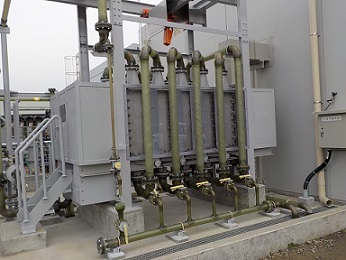
Unipolar electrolytic tank
50 kg/h ÷ 7 kg/h (amount generated per one 15WL electrolytic tank) = 7.1 tanks → 8 tanks (model: 15WL-8)
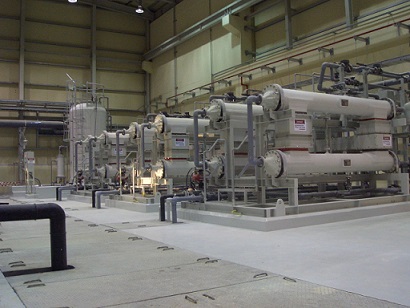
Bipolar electrolytic tank
50 kg/h ÷ 16 kg/h (amount generated per one 15BL-10 electrolytic tank) = 3.1 tanks → 4 tanks (model: 15BL-10-4)
Performance
Delivery record
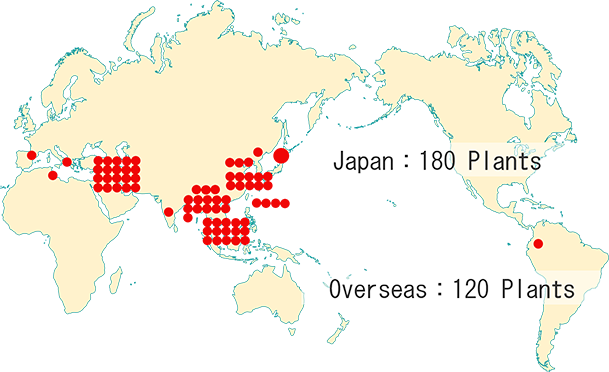
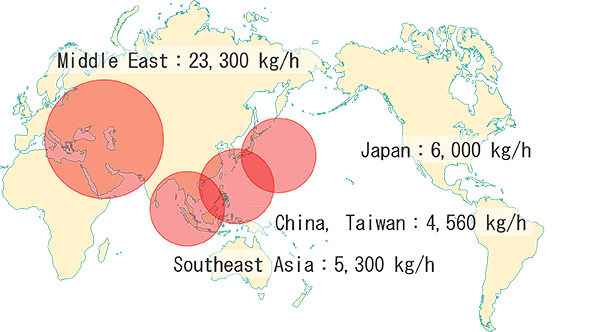
Approx. 42,000 kg/h (total) (as of February 2021)
Related technology
Click here for inquiries about Hitz technology
